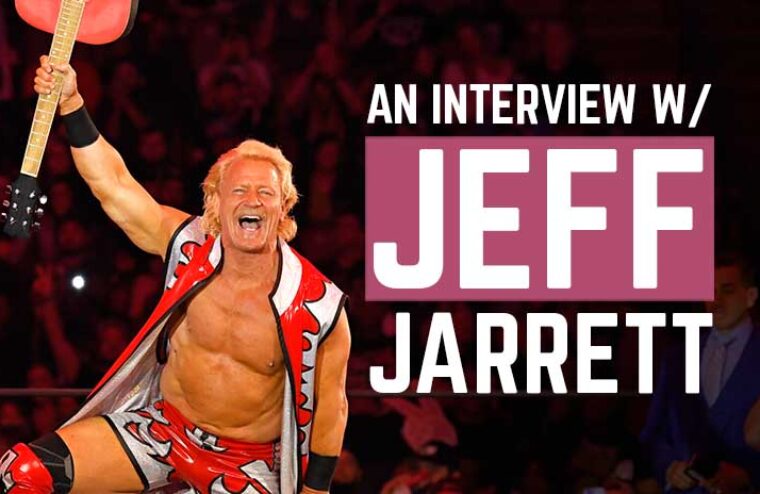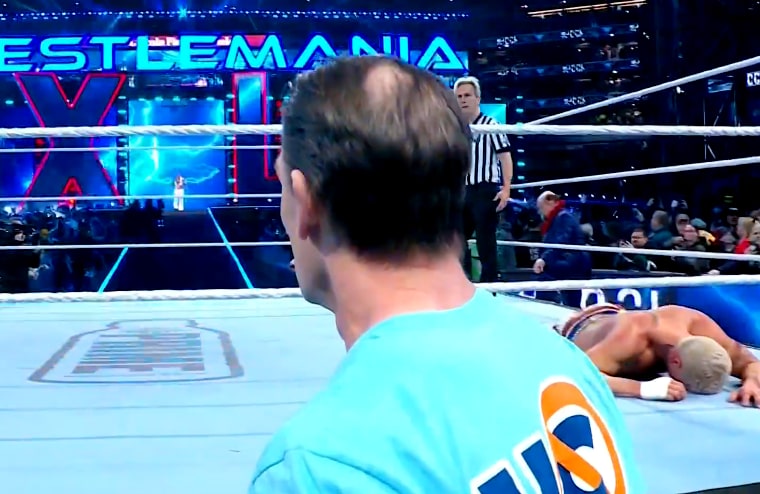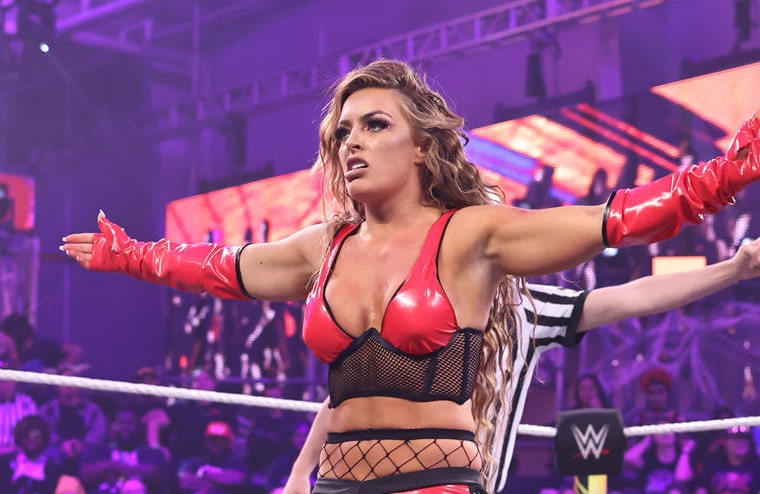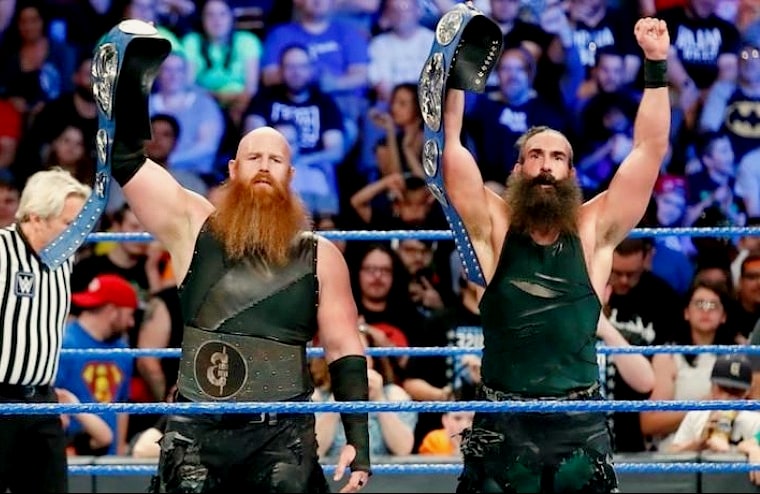When it comes to professional wrestling, Jeff Jarrett has certainly been around the block a time or two. A WWE and Impact Wrestling Hall Of Famer, Jarrett has a storied and accomplished career, and his legendary family’s history in wrestling dates back to 1946.
So when Jarrett talks up a wrestling company, it’s weighty praise. The 55-year-old ring legend is as excited as ever to be part of All Elite Wrestling as both an in-ring talent and the Director of Business Development.
“Looking at the entire industry, when you look at AEW and the growth in a relatively short amount of time, to have five hours of primetime television and a global presence, and to sell 60,000 tickets to Wembley, is such a statement,” Jarrett said. “The AEW brand, the entrepreneurial spirit and the growth is like a rocket ship.”
Jarrett’s influence is not only felt behind the scenes at AEW but also on camera. Since joining the company in November, Jarrett has tangled with some of the company’s top talents, and he and Jay Lethal will take a crack at capturing the AEW World Tag Team Championships on Sunday at Double Or Nothing when they face current champs and fan favorites, FTR. Mark Briscoe, who has a lengthy and/or special connection to both teams, will serve as the special guest referee.
“AEW’s growth is something I’ve watched from the very beginning, literally show No. 1,” Jarrett said. “I was part of the Chicago show that was the precursor to it all when I walked Nick Aldis to the ring. To see the evolution of it is super exciting, and to get this opportunity to do what I’m I’m doing as far as my in-ring career, I don’t think anyone could’ve called this.”
Recently, Jarrett talked all things AEW, his match at Double Or Nothing and reminisced about being a part of Ric Flair’s final match in this Web Is Jericho exclusive.
What’s your experience been like joining AEW, and how does it compare to wrestling companies you’ve worked with in the past? “My grandmother got into the business in 1946. So the evolution of the business is always moving and always changing. I understood that from a very young age. One thing absolutely for sure especially in the wrestling industry, nothing ever stays the same. No matter how much you think it’s going to. Over the last 10 years, the evolution from cable to streaming and social media and all the digital platforms, that is something that continues to excite me. I love the business today more than when I broke in by a long shot.”
When did the idea come about for the current feud against FTR? “Like some things in this industry, they may take different shapes and fashions, but candidly, the cream always rises to the top regardless. That’s the nature of not just the wrestling business, but the entertainment business. And surely in the sporting world, you have Cinderella stories or people that might be a long shot. But at the end of the day, talent and hard work equals success. It goes without saying that Jay Lethal is a super accomplished wrestler in his own right. I think my two Hall Of Fames kind of speak for themselves. You look at Satnam Singh, he’s truly a one-in-a-billion talent. The addition of the villain known as Karen Jarrett, and then Sonjay Dutt — we’re a very formidable package and check a lot of boxes. So when you look over the last 90 days, things have been clicking with our group, and I think the proof’s in the pudding as things roll out.”
With four seasoned vets squaring off against one another, who leads who in your upcoming tag title match? “Competitive juices is one of the things that makes in-ring performers tick. Getting geared up for the big one, to have the opportunity for tag team gold, and putting four veterans in the ring, we’re gonna be super aggressive, all four of us. We’re gonna be super competitive. We’re gonna come ready. You got a little taste already, not just the guitar shots but the brawls around the ring. We all come with our game face on. That being said, I don’t want to say it’s a collaborative effort, because I think it’s gonna be a bit of a tug of war, mentally and physically, and that’s what I love about the in-ring performance side of things. I love that mental chess that you have to play with one another whether it’s sitting down in the locker room, or going out to ringside, you better be on your A-game, or you’ll get left in the dust.”
AEW has started running house shows under much of your direction. How have those gone so far? And what can the AEW roster learn on some of these shows that perhaps they wouldn’t get on a Dynamite or Rampage? “You’re talking to a 37-year vet. When the opportunity (to come to AEW) came up back in November, I knew that the non-televised live events weren’t really on the docket. Me being from Nashville, essentially the hub for music and the touring side of the music industry, I’ve certainly done my due diligence, and realized for lack of a better term, the supply and demand. (Supply and demand) determines the success of the marketplace. You look at Wembley as the perfect example. Been in the market for four-plus years but not one live event. Put tickets on sale to Wembley, and you’re north of 60,000 (tickets sold).”
“Here in America you have multiple brands running seven nights a week, so to speak, but the House Rules Tour, what an opportunity. A lot of people have asked me, ‘What is the agenda or the business model?’ It goes without saying that it creates revenue. Not just from ticket sales but from merchandise sales and your licensing partners. That’s one aspect. But with the talent development and opportunities, there will be multiple talent out of this House Rules tour that get their footing and traction. With the ability to be on social media all the time, it’s really about building your individual brand. The talent that’s on these shows, they’re gonna have a leg up and get traction, because it is about talent development and character building.”
“But at the end of the day as far as AEW relates to House Rules, it’s brand building. You have the pay-per-view and Dynamite and Collision markets that are the A and B. The House Rules are the C and D markets, but I can assure you it’s an enormous marketing initiative for the brand. You look at pro wrestling since the national expansion in the 80s, it’s all brand building. Our competitors in WWE continue to do a marvelous job of going into all sizes of markets and building the strength of the brand. That’s exactly where AEW is rolling along. We’ve got to build our brand. In five short years to have five hours of television on primetime is awesome, but it’s about creating that emotional connection with your viewers, your consumers and your fans. House Rules checks all those boxes.”
With a lot of promising young talent in AEW, from your vantage point as a veteran, is there anyone on the roster that you see as being the next big star? “That’s a loaded question. I’ll leave that to the armchair quarterbacks, but I’ll say this. With a bias, Satnam. His (2016) documentary is so appropriately named, ‘One in a Billion.’ They obviously meant that from the NBA connotation, that he’s a kid from India who moved here to the states as a 14-15 year old. And the population of India is a billion. But when you kind of look at his life path, and look at the upside and the potential, it’s not every day you have a 7-foot-4, 26-year-old — I’ll call him kid —who has a professional basketball background. It’s just kind of amazing you have a kid like that who has an incredible passion for professional wrestling. He really is a one-in-a-billion talent. His athletic ability, where he’s from. He’s bilingual. At the end of the day he loves wrestling just like me and Jay and Sonjay do, and that is something that I think is a recipe for an incredible success story, if he does the work.”
Is it challenging for you to balance both your on screen and behind the scenes roles? “I’ve never not really had two roles. I broke into the business, and my first job was riding with my grandmother and handing out window cards. So (there was) the marketing aspect, or concessions, or pulling the ring. And then you break into the business, and whether it was a blessing or curse or little bit of both, it’s been a family business. My family has been in the wrestling business since 1946. Going to WWF and going to WCW and founding my own organization, I’ve always really worn more than two hats, so it’s really nothing new to me. It’s one of the things I enjoy and love. The business continues to evolve, and although I may have a lot of years experience, I’m always looking for, ‘How are they doing this different? How are they doing this new?’ That also goes with the talent that’s in the ring. When you look at our roster — and this isn’t just the promoter cap of Jeff saying this — it is the most athletic and diverse roster that I think has ever been put together. The roster is super diverse and super athletic and of all ages. You look at me and Sting and Chris and some others that are vets, but then you look at the primetime players and our main event in Vegas with the four pillars, it checks all the boxes of diversity and I think that’s very exciting about the brand.”
What did it mean for you to wrestle in Ric Flair’s last match? And do you indeed think it will be the last one he does? “That entire thing, with Conrad Thompson being my business partner and his father-in-law being Ric, it was really unique. There’s a whole documentary that might be told on that one day just how it all fell together and how the pieces fell in and the success of it. Folks at times have been very critical of it, but now that we’re nine months removed, I truly think there’s three buckets of people. You were either there live, watched it on Fite or you weren’t there. And there’s three drastically different opinions. But there was electricity in that arena that is almost such a rarity in this business. And I’m giving Ric the credit, because the legendary status of himself and everything that went into it, look the financials of it, and they’ve reported on it, it was astounding. It was an honor for me. When you look at the role I played in this industry, for me to get to do the honors from one of the greatest of all time in my hometown, it’s truly an honor and a memory I’ll take to my grave. A very, very special night in so many ways.”
“Now, do I think it’s his last one? We’re in the entertainment industry, so you never can say never. You can kind of have a wishlist and say this and say that. But I know one thing, the marketing that Conrad and team and all the partners that came together, it would certainly be hard to duplicate just the magic. The Crockett involvement in it, Ric’s mindset, the videos that were shot, the press conference that we had with the mayor and the government officials in town. There was a lot of time and energy and thought process that went into it. It really was a special weekend.”
- AEW Star Was Encouraged To Ask WWE For A Tryout - April 17, 2024
- Metallica’s James Hetfield Put Lemmy’s Ashes To Use In Touching Tribute - April 17, 2024
- Living Colour Frontman Shares How He Really Feels About “Cult Of Personality” - April 16, 2024




